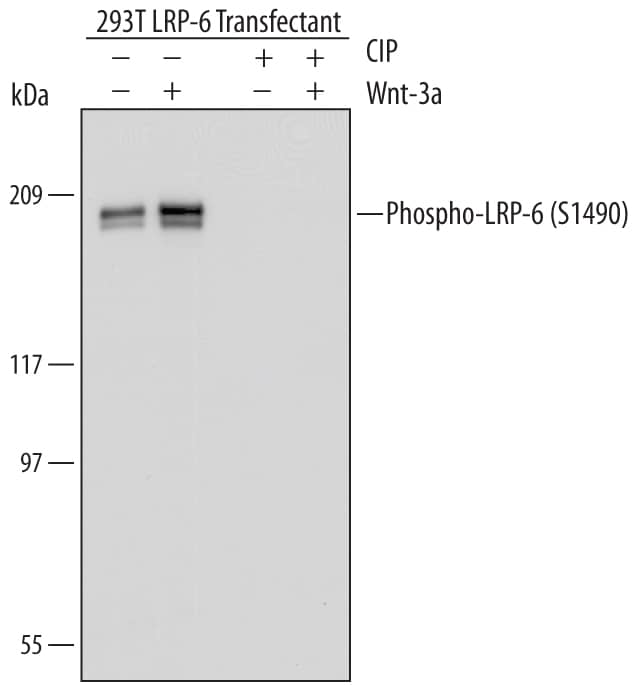Human Phospho-LRP-6 (S1490) Antibody
R&D Systems, part of Bio-Techne | Catalog # AF6649

Key Product Details
Validated by
Species Reactivity
Validated:
Cited:
Applications
Validated:
Cited:
Label
Antibody Source
Product Specifications
Immunogen
Specificity
Clonality
Host
Isotype
Scientific Data Images for Human Phospho-LRP-6 (S1490) Antibody
Detection of Human Phospho-LRP‑6 (S1490) by Western Blot.
Western blot shows lysates of 293T human embryonic kidney cell line transfected with human LRP-6 untreated (-) or treated (+) with 100 ng/mL Recombinant Human Wnt-3a (High Purity) (Catalog # 5036-WNP) for 15 minutes. PVDF Membrane was probed with 1 µg/mL of Rabbit Anti-Human Phospho-LRP-6 (S1490) Antigen Affinity-purified Polyclonal Antibody (Catalog # AF6649) followed by HRP-conjugated Anti-Rabbit IgG Secondary Antibody (Catalog # HAF008). A specific band was detected for Phospho-LRP-6 (S1490) at approximately 200 kDa (as indicated). The phospho-specificity of this antibody was supported by decreased labeling following treatment with 300 U/mL CIP for 1 hour. This experiment was conducted under reducing conditions and using Immunoblot Buffer Group 1.Applications for Human Phospho-LRP-6 (S1490) Antibody
Western Blot
Sample: 293T human embryonic kidney cell line transfected with human LRP-6 treated with Recombinant Human Wnt‑3a (High Purity) (Catalog # 5036-WNP)
Formulation, Preparation, and Storage
Purification
Reconstitution
Formulation
Shipping
Stability & Storage
- 12 months from date of receipt, -20 to -70 °C as supplied.
- 1 month, 2 to 8 °C under sterile conditions after reconstitution.
- 6 months, -20 to -70 °C under sterile conditions after reconstitution.
Background: LRP-6
LRP6 (Low-density lipoprotein receptor-related protein 6) is a 200-210 kDa member of the LDLR family of proteins. It is widely expressed, and serves as a coreceptor for both Wnt and parathyroid hormone. In the Wnt system, LRP6 associates with select Fzd multipass receptors; in the PTH system, LRP6 complexes with PTHR1. Mature human LRP6 is a 1594 amino acid (aa) type I transmembrane glycoprotein. It contains a 1351 aa extracellular region (aa 20-1370) plus a 220 aa cytoplasmic domain (aa 1394-1613). The cytoplasmic domain contains two palmitoylation sites, one ubiquitination residue, and multiple phosphorylation motifs. Ser1490 is a key residue that impacts multiple activities. It undergoes both constitutive and receptor activation-induced phosphorylation. At least three enzymes likely act at this site, including PKA (associated with PTHR1), GSK-3 (associated with Fzd) and Cyclin Y/PFTK1 (associated with G2/M of the cell cycle). In general, Ser1490 phosphorylation results in beta-catenin stabilization, followed by either gene transcription or beta-catenin binding to centrosomes.
Long Name
Alternate Names
Gene Symbol
Additional LRP-6 Products
Product Documents for Human Phospho-LRP-6 (S1490) Antibody
Product Specific Notices for Human Phospho-LRP-6 (S1490) Antibody
For research use only
